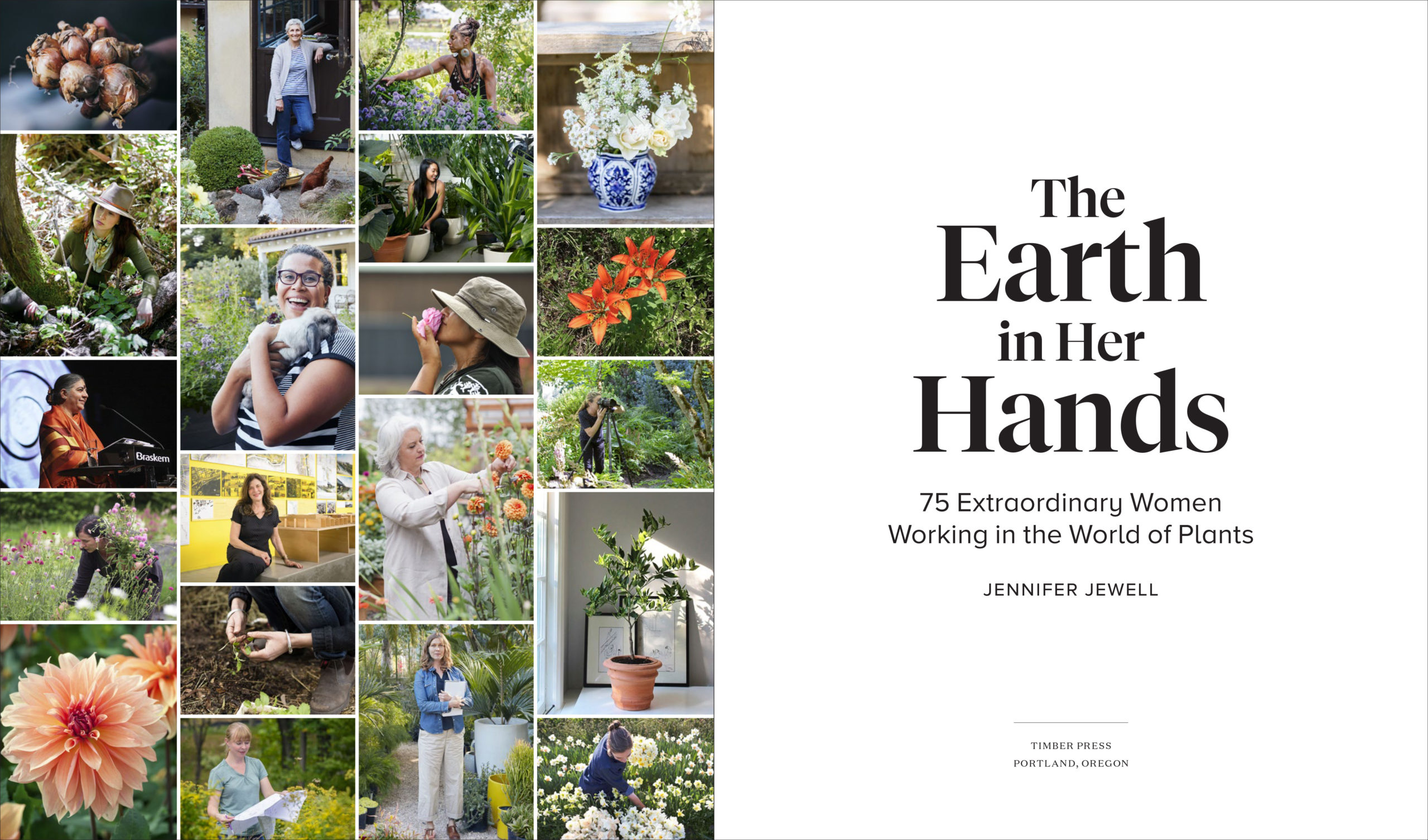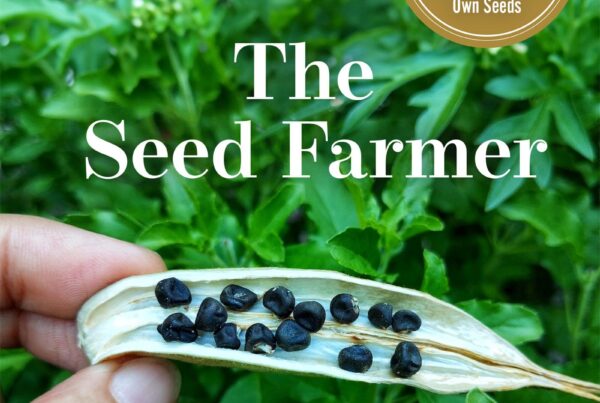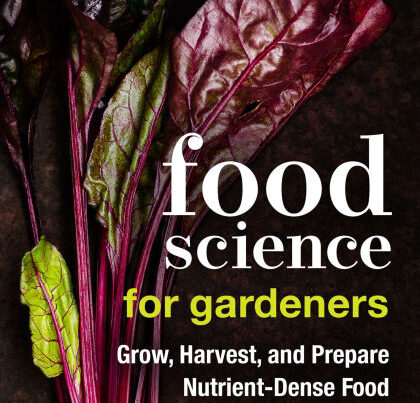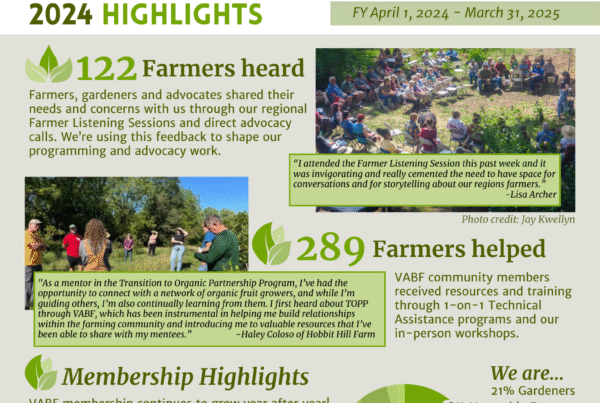Jennifer Jewell is the host of the radio program and podcast Cultivating Place, produced at an NPR station in Northern California; the writer of many gardening articles, and an advocate for gardening. Here she has assembled a four-page spread on each of 75 women.
Over 40 of the contributors describe themselves as writers or educators, and 24 as gardeners or farmers. I expect the total is higher, and that many contributors are excellent home gardeners, but didn’t mention it. The next biggest category is the 20 women who work as designers or architects of landscapes, parks or gardens. Overlapping these designers of spaces is the group of 8 floral designers.  This group is followed by the 15 who are some kind of public or school garden manager, director or administrator. Around a dozen (and I imagine more) are workers and advocates for social and environmental justice. There’s a group of about 25 who describe themselves as nurserywomen, horticulturists, plantswomen, botanists, plant hunters and native plant experts. Over a dozen are scientists and advocates in the field. A small group are plant breeders, seed farmers and seed scientists. And finally there are about ten garden, landscape or plant photographers and artists. I was disappointed there aren’t more vegetable growers, but I know writers write about what they know best.
One of Jennifer Jewell’s missions has been to Decolonize the Garden, to get away from images of middle-aged middle-class white people, working in the US with plants imported from Europe; and to do this without appropriating other people’s culture. Some of the women profiled address this issue directly. The women presented are mostly from the English-speaking countries of the world, but not only; majority white, but diverse in ethnicity, socioeconomic and religious backgrounds, sexual orientation and age. Each woman concludes her interview with a short list of one to four other inspiring women, either women who preceded them, or upcoming women more of us will want to know about. Some are very personal choices (family members), some are well-known; sometimes there are details, sometimes not.
Some of the women are world famous in the growers’ world, like Vandana Shiva, Elaine Ingham, Jamaica Kincaid, Leah Penniman, Margaret Roach and Renee Shepherd. Some are famous Virginians, such as Ira Wallace from Southern Exposure Seed Exchange, Beth Tuttle president and CEO of the American Horticultural Society, Claudia West the landscape designer in Arlington, and Peggy Cornett at Monticello. Others we meet for our first time.
Each profile starts with Her Work, Her Landscape (or Her Plant), and Her Plant Journey.
Here are some of the gems I picked out from this book:
“Fear is a great motivator, and there’s no magic. Get up early and really work hard, show up on time, be nice, don’t overcharge, get a client and look after them. Be enthusiastic. You have to be knowledgeable—I’ve given myself a challenging education—I am open to other people’s thoughts, and I ask questions. I remain deeply grateful for all the people who have generously shared their knowledge and allowed me to learn from them. I try to repay this generosity every chance I get.†(Jinny Blom)
There are “plant people and there are garden people. Plant people focus on individual plants and collecting, garden people focus on the whole experience and space creation. . . I get obsessed with plants, but I don’t abide a plant that isn’t doing its job well in the garden.†(Flora Grubb)
“You may not like living with us now, but conservationists make great ancestors.†(Jean Siddall)
“One [of the three cooperatively determined goals at Soul Fire Farm]: grow 80,000 pounds of food intensively on two acres of land using low-till methods, sequestering 2400 pounds of carbon, growing over a dozen African-indigenous heritage crops, and demonstrating several African-indigenous sustainable farming practices. Two: train eighty-plus new farmer-activists of color through our Black and Latinx Farmers Immersion and its apprenticeship program, and mentor eighty-plus BLFI alumni. Three: train and inspire 250-plus youth of color through our food-justice empowerment program and immersion.†(Leah Penniman and Soul Fire Farm)
“Growing up, when cheap eggs were still more interesting to most people than free-range eggs, my mother . . . believed passionately that chickens have a right to run free and should be allowed to do so. How is it possible that we have people in our society without access to healthful food and green space? Even more enraging to me is that we are producing food that won’t ensure our long term health on this planet. How is it possible that we don’t care more about future generations than we do about producing too much cheap food poorly now?†(Alys Fowler)
“I recently heard form Sarah Milligan Toffler, director of the Atlanta Children &Nature Network, that children in the United States spend less time outdoors than prisoners. That took my breath away and puts fear into my heart. Public gardens are one antidote to that. They are a safe place to get kids into nature. Once there, being there, learning there, loving and caring about nature—they are inoculated for life!†(Mary Pat Matheson)
“Her diverse forty-member team at Studio-MLA includes landscape architects, urban designers, community advocates, botanists, ecologists, and technical experts, with a purposeful 50:50 men-to-women ratio from different ethnic and cultural backgrounds.†(Mia Lehrer). (Hopefully by now they have even gone beyond the binary gender classification.)
“When I first started attending conferences and meeting with growers, I would often be the only woman in a group meeting with a seed producer. Where others were mostly concerned with shipping and packing capacity, I was asking to compare varieties for flavor. Fortunately, that is changing now, as consumers are looking for more tasty produce.†(Renee Shepherd, owner of Renee’s Garden seed business).
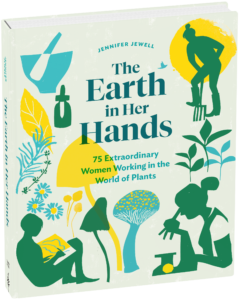 I sighed to read that Jekka McVicar has been the only woman chair of the judging of the great floral pavilion at the Chelsea Flower Show (up to 2018). She has won 62 RHS gold medals since she started contributing to their displays and gardens in 1993. She was the only certified organic grower at the Chelsea Show, and she used the platform to “make a call for more insect-friendly gardening.â€
I sighed to read that Jekka McVicar has been the only woman chair of the judging of the great floral pavilion at the Chelsea Flower Show (up to 2018). She has won 62 RHS gold medals since she started contributing to their displays and gardens in 1993. She was the only certified organic grower at the Chelsea Show, and she used the platform to “make a call for more insect-friendly gardening.â€
I was somewhat cheered to read that Julie Kierstead Nelson benefitted in the late 80’s, from a class-action lawsuit against the US Forest Service for discriminating against women, and several congressional acts, including the Clean Water Act and the Endangered Species Act. The convergence of these forces helped her get the job she was seeking.
“As long as we keep topping off architects’ buildings with green roofs, we’re fiddling while Rome burns. We’re seven billion people now—we have to really figure out how to build cities, not just buildings.†“Great landscape design can moderate extreme heat, recycle water, reduce energy use, lower carbon emissions, and attract people to urban areas.†(Martha Schwartz)
The mandate for Sunset magazine in the Southwest “to not promote thirsty plants, potentially invasive plants, or plants with high pest problems,†(Kathleen Brenzel, the editor).
Claudia [West] believes that cultivated plantings of all kinds “must be beautiful, inspire, have emotional content, and provide high ecological value and function. They must feed and provide habitat for wildlife, clean our air, soak up and purify polluted stormwater runoff, sequester carbon, treat soil contamination, and reduce noise in our cities.â€
“. . .A modest little idea we had to stage as a horticultural revolt. We were tired of what the mainstream gardening media had to offer—warmed-over garden tips, repurposed press releases about the ten thousandth new coleus on the market, dull little essays about the wonders of spring—and we were convinced that bloggers could overthrow the gardening establishment. Like all good revolutionaries, we began by writing a manifesto.†(Amy Stewart, cofounder of the Garden Rant blog platform).
I enjoyed the pieces about urban farming (Yolanda Burrell); the young farmers’ movement (Severine von Tscharner Fleming); the organic Seed Alliance (Cara Loriz); the Berry Botanic Garden in Portland Oregon, where Julie Kierstead Nelson started a seed bank for rare and endangered plants of the Pacific Northwest; the work of Martha Schwartz at Harvard showing compelling results from integrating afforestation into urban landscapes; Fern Verrow farm in Herefordshire, England, where Jane Scotter and her husband grow food for chef Skye Gyngell at her restaurant Spring, in London; the work of Vandana Shiva and others in India to prevent the neem tree from being patented; Lauren Springer’s thirty-year career, introducing 50-60 new plants to the dry Intermountain West, providing more regionally-adapted resilient, beautiful plants; the Buehler Enabling Garden within the Chicago Botanic garden, a display garden made for people with disabilities, including PTSD “we do a lot of work with veterans who cope with hypervigilance. Here they can monitor the entry and exit points and feel protected by the walls without a sense of mystery.†(Barbara Kreski),
Cultivating Place podcaster and Heritage Harvest Festival 2020 presenter Jennifer Jewell learned to love the outdoors and gardening from her parents. The award-winning author shares reflections and a recommendation for the perfect family gardening project, Compost Your Worries, Share Your Joys, on the HHF blog. Journey with Jewell to find silver linings during this challenging time
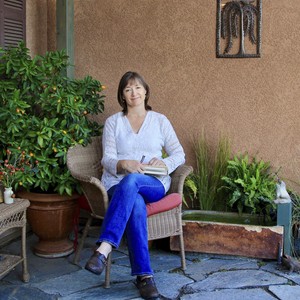
Book Review: The Earth in Her Hands: 75 Extraordinary Women Working in the World of Plants, by Jennifer Jewell, Timber Press, 2020. 312 pages, full color photos throughout, $35.
BY: Pam Dawling

